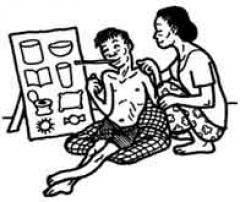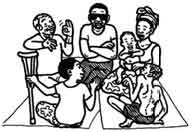Your progress
0%
Here are some of the key ideas you need to support people with disabilities so they can advocate for themselves.
Use your mouse or keyboard to expand each of the headings below.
Self-advocacy is about people having a voice of their own. It means:
Self-advocacy is important because many people with disabilities are not always listened to, not allowed to make decisions about themselves and told what to do by others. Self-advocacy is critical to fight for the right to decide about their own lives.
Learn how young people made a difference by speaking out in support of a major international agreement that affected them


Children with disabilities played an important role in negotiations during development of the Convention on the Rights of Persons with Disabilities (CRPD).
| In January 2006 | In March 2007 |
|---|---|
|
A group of children from Bangladesh, China and the UK went to New York to present their perspectives on why the Convention needed to include specific measures to protect their rights. In a written statement, they highlighted the need to recognize the importance of:
|
Two young disability advocates from Nicaragua and Armenia attended the Convention’s signing ceremony. They reminded delegates of the need to pay special attention to the situation of children with disabilities in the implementation of the new Convention. |
The participation of these young people affirmed that children with disabilities can be effective advocates for their own rights and are entitled to be involved in decisions that affect them.
In many settings, people with disabilities experience stigma and discrimination, which is made worse when other layers of discrimination like gender, ethnicity, sexual orientation, religion, socio-economic status are present. This can make it very difficult to express their opinions, wants and needs. Often people with disabilities will need support to learn self-advocacy skills.
While self-advocacy is an important goal for people with disabilities, in some situations they may request or need the support of an advocate. An advocate might be:
An advocate might assist a person with a disability to:
When support is required, the advocate should respect the rights, will and preferences of the person with a disability. In addition, the advocate should provide only as much support as the person’s circumstances require, and the support should last for the shortest time possible.
Communication is the way information and messages are transferred from one person to another and is the means that relationships between individuals and communities are built and maintained.
While self-advocacy is about having a voice of your own, it does not mean literally having a voice. Some people with disabilities cannot talk or communicate easily with others, but use other modes of communication such as Sign language.
Learn how a young boy who cannot speak learned to communicate


Trang is 14 years old. He lives with his family in a remote hill village. Trang has cerebral palsy, which has resulted in a communication impairment.
Other people are unable to understand his speech; and he cannot use sign language because his motor movements are uncoordinated.
Trang’s aunt approached the CBR and asked for help.
CBR personnel helped create a communication board, which contained pictures of the most important activities and items in Trang’s life.
Trang now uses this board to express his needs, exchange information and converse with his family and friends. CBR personnel have also encouraged his family to start teaching Trang to read.

Self-advocacy also means that people with disabilities need to be listened to, and it is important to identify barriers to communication, such as lack of communication assistive devices, attitudes of people who avoid communicationwith those who have a difficulty expressing themselves and complexity of the message.